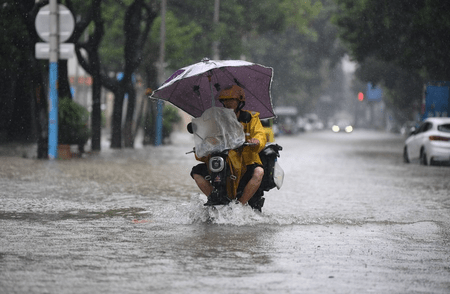Beijing, Aug 2 (IANS) China renewed weather alerts on Saturday, warning of rainstorms and high temperatures in several regions.
The National Meteorological Centre (NMC) maintained a yellow alert for rainstorms, forecasting heavy rainfall from Saturday to Sunday across parts of Inner Mongolia, Heilongjiang, Jilin, Liaoning, Shanxi, Hebei, Beijing, Tianjin, Jiangsu, Shanghai, Zhejiang, Anhui, Jiangxi, Fujian, Guangdong, Guangxi, Yunnan and Taiwan island.
Some of these regions may experience hourly precipitation topping 70 millimetres, accompanied by thunderstorms and gales, according to the NMC.
Local governments have been urged to take necessary precautions and inspect drainage systems in cities, farmlands and fishponds.
The NMC has also renewed a yellow alert for high temperatures in multiple regions.
High temperatures ranging from 35 to 39 degrees Celsius are expected in parts of northern China, Shaanxi, regions between the Yellow River and the Huaihe River, the Jianghan Plain, the Sichuan Basin, areas south of the Yangtze River, southern China, Xinjiang, Gansu, Inner Mongolia, during daylight hours on Saturday.
Temperatures in parts of Shaanxi, Sichuan, Chongqing and the Turpan Basin in Xinjiang may exceed 40 degrees Celsius, the NMC said.
The centre has advised people to take protective measures and avoid excessive sun exposure, Xinhua news agency reported.
China has a four-tier weather warning system, with red representing the most severe warning, followed by orange, yellow and blue.
Earlier on July 28, water conservancy authorities had announced China’s No.1 flood of major rivers of 2025 in the Luanhe River, located in north China’s Haihe River Basin.
Due to recent heavy rainfall, the Luanhe River has experienced a rise in water levels.
Beijing, also located in the Haihe River Basin, has been experiencing heavy rainfall over the past few days. Torrential rains, notably, had resulted in the evacuation of more than 3,000 residents in Beijing’s suburban district of Miyun.
China has been experiencing floods since 1998. This practice can remind the public of which rivers are flooding and enhance public awareness of flood risk prevention. It also alerts flood control departments about the potential risk of embankment failures and the need to strengthen patrols and inspections of embankments and flood prevention work.
–IANS
int/jk/sd
Disclaimer
The information contained in this website is for general information purposes only. The information is provided by BhaskarLive.in and while we endeavour to keep the information up to date and correct, we make no representations or warranties of any kind, express or implied, about the completeness, accuracy, reliability, suitability or availability with respect to the website or the information, products, services, or related graphics contained on the website for any purpose. Any reliance you place on such information is therefore strictly at your own risk.
In no event will we be liable for any loss or damage including without limitation, indirect or consequential loss or damage, or any loss or damage whatsoever arising from loss of data or profits arising out of, or in connection with, the use of this website.
Through this website you are able to link to other websites which are not under the control of BhaskarLive.in We have no control over the nature, content and availability of those sites. The inclusion of any links does not necessarily imply a recommendation or endorse the views expressed within them.
Every effort is made to keep the website up and running smoothly. However, BhaskarLive.in takes no responsibility for, and will not be liable for, the website being temporarily unavailable due to technical issues beyond our control.
For any legal details or query please visit original source link given with news or click on Go to Source.
Our translation service aims to offer the most accurate translation possible and we rarely experience any issues with news post. However, as the translation is carried out by third part tool there is a possibility for error to cause the occasional inaccuracy. We therefore require you to accept this disclaimer before confirming any translation news with us.
If you are not willing to accept this disclaimer then we recommend reading news post in its original language.

